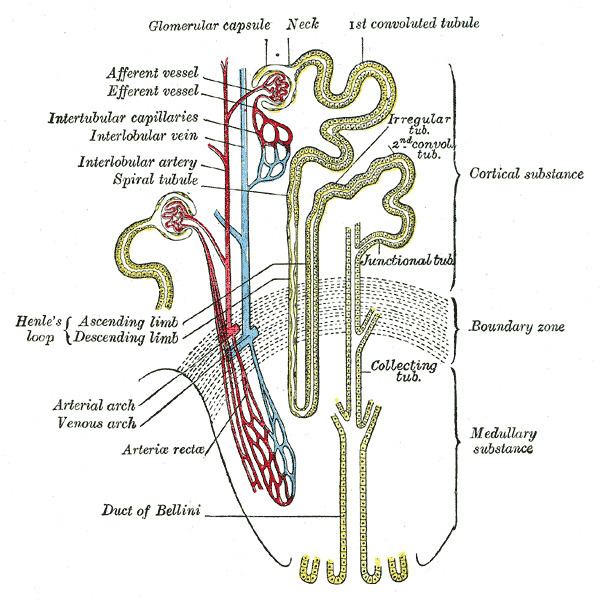Precursor Ureteric bud Artery vasa recta Dorlands
/Elsevier d_29/12314994 | System Urinary System Latin ductus papillaris TH H3.06.00.1.00086 | |
 | ||
Papillary (collecting) ducts are anatomical structures of the kidneys, previously known as the ducts of Bellini. Papillary ducts represent the most distal portion of the collecting duct system. They receive renal filtrate (precursor to urine) from several medullary collecting ducts and empty into a minor calyx. Papillary ducts continue the work of water reabsorbtion and electrolyte balance initiated in the collecting tubules.
Contents
Structure
Medullary collecting ducts converge to form a central (papillary) duct near the apex of each renal pyramid. This "papillary duct" exits the renal pyramid at the renal papillae. The renal filtrate it carries drains into a minor calyx as urine.
Cells of upper duct
The cells that comprise the duct itself are similar to rest of the collecting system. The duct is lined by a layer of simple columnar epithelium resting on a thin basement membrane. The epithelium is composed primarily of principle cells and α-intercilated cells.383
Cells of lower duct
The simple columnar epithelium of the collecting duct system transitions into urothelium near the junction of a papillary duct and a minor calyx.
Renal filtration physiology
These cells work in tandem to reabsorb water, sodium, and urea and secrete acid and potassium. The amount of reabsorbtion or secretion that occurs is related to needs of the body at any given time. These processes are mediated by hormones (aldosterone, vasopressin) and the osmolarity (concentration of electrically charged chemicals) of the surrounding medulla.
Hormones regulate how permeable the papillary duct is to water and electrolytes. In the medullary collecting duct specifically, vasopressin upregulates urea transporter A1. This increases the concentration of urea in the surrounding interstitium and increases the osmolarity.
Osmolarity influences the strength of the force that pulls (reabsorbs) water from the papillary duct into the medullary interstitium. This is especially important in the papillary ducts. Osmolarity increases from the base of the renal pyramid to the apex. It is highest at the renal apex (up to 1200 mOsm). Thus the force driving the reabsorbtion of water from the collecting system is the greatest in the papillary duct.
Collecting duct carcinoma
Carcinoma of the collecting duct is a relatively rare subtype of renal cell carcinoma (RCC), accounting for less than 1% of all RCCs. Many reported cases have occurred in younger patients, often in the third, fourth, or fifth decade of life. Collecting duct carcinomas are derived from the medulla, but many are infiltrative, and extension into the cortex is common. Most reported cases have been high grade and advanced stage and have not responded to conventional therapies. Most patients are symptomatic at presentation. Immunohistochemical and molecular analyses suggest that collecting duct RCC may resemble transitional cell carcinoma, and some patients with advanced collecting duct RCC have responded to cisplatin- or gemcitabine-based chemotherapy.
